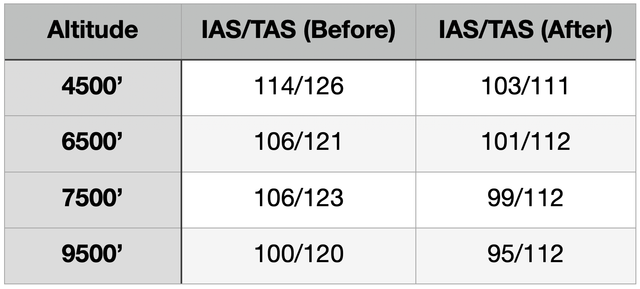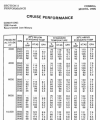kicktireslightfires
Pre-takeoff checklist
- Joined
- Jun 11, 2020
- Messages
- 343
- Display Name
Display name:
kicktireslightfires
I just flew another test flight and took it up to 12,600' DA.
Previously, at 12,600 DA I was flying:
120 KTAS
105 KIAS
5400 RPM
3.8 GPH
Now at 12,600 DA I’m flying:
110 KTAS
91 KIAS
5430 RPM
3.7 GPH
Fire-walling it doesn’t accomplish much:
112 KTAS
92 KIAS
5550 RPM
4.8 GPH
I confirmed I have both a decrease in cruise speed *and* climb performance.
Also confirmed engine RPM is accurate, or at least during idle it is. On the ground, the iPhone app is amazing and told me it was within 10rpm of what my EMS was showing. In the air, it wouldn't give a read and I think that's because there's too many other noises, including the prop. Still going to test the prop speed as soon as the TruTachII arrives.
Previously, at 12,600 DA I was flying:
120 KTAS
105 KIAS
5400 RPM
3.8 GPH
Now at 12,600 DA I’m flying:
110 KTAS
91 KIAS
5430 RPM
3.7 GPH
Fire-walling it doesn’t accomplish much:
112 KTAS
92 KIAS
5550 RPM
4.8 GPH
I confirmed I have both a decrease in cruise speed *and* climb performance.
- Previously 6 minute climb to 6,600’ DA, now 8.5 minutes (+2.5m)
- Previously 9m to 8,900’ DA, now 12m (+3m)
- Previously 12.5m to 10,900’ DA, now 15m (+2.5m)
- Previously 17m to 12,400’ DA, now 18.5m (+1.5m)
Also confirmed engine RPM is accurate, or at least during idle it is. On the ground, the iPhone app is amazing and told me it was within 10rpm of what my EMS was showing. In the air, it wouldn't give a read and I think that's because there's too many other noises, including the prop. Still going to test the prop speed as soon as the TruTachII arrives.


